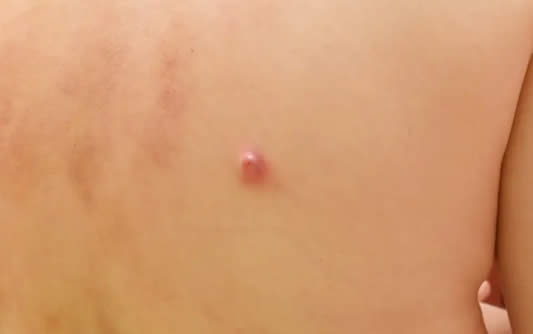
Boils, also known as furuncles, are painful and inflamed lumps that form beneath the skin. They are caused by an infection in a hair follicle or oil gland. Boils can occur anywhere on the body, but are most commonly found on the face, neck, armpits, buttocks, and thighs. In this article, we will discuss the causes, symptoms, types, and treatments for boils.
Causes of Boils
Boils are most commonly caused by the bacteria Staphylococcus aureus. This bacteria normally lives on the skin and in the nose, but can enter the body through a cut or break in the skin. Boils can also be caused by other types of bacteria, such as Streptococcus pyogenes.
Other factors that can increase the risk of developing boils include:
- Poor hygiene
- Diabetes
- Weakened immune system
- Friction from tight clothing or shaving
- Exposure to harsh chemicals
- Certain medications, such as steroids
Symptoms of Boils
Boils typically start as a red, painful bump that gradually increases in size over a few days. They can range in size from a pea to a golf ball, and may be accompanied by a fever or general feeling of illness. As the boil grows, it may develop a white or yellow center, which is pus that has accumulated under the skin. The skin over the boil may also become tender and swollen.
Types of Boils
There are several types of boils, including:
- Furuncles: single boils that occur on the skin and are typically caused by Staphylococcus aureus.
- Carbuncles: clusters of boils that are often larger than furuncles and can be very painful. Carbuncles are more likely to cause a fever or other systemic symptoms than furuncles.
- Cystic acne: deep, painful, and inflamed cysts that occur on the face, neck, chest, and back. These cysts are caused by blocked hair follicles.
Treatments for Boils
Most boils will heal on their own within a few weeks. However, there are some treatments that can help alleviate the pain and speed up the healing process. These treatments include:
- Applying warm compresses to the affected area for 10-15 minutes several times a day.
- Taking over-the-counter pain relievers, such as ibuprofen or acetaminophen, to alleviate pain and reduce inflammation.
- Keeping the affected area clean and dry to prevent further infection.
- Taking antibiotics if the boil is severe or if there are multiple boils.
- In rare cases, a boil may need to be drained by a healthcare professional. This involves making a small incision in the skin and draining the pus out of the boil.
Preventing Boils
There are several steps you can take to prevent the development of boils, including:
- Practice good hygiene, such as washing your hands regularly and showering after exercise or heavy sweating.
- Avoid sharing personal items, such as towels, razors, or clothing.
- Avoid tight clothing that may cause friction on the skin.
- Treat any cuts or breaks in the skin promptly with antiseptic to prevent infection.
Boils can be painful and uncomfortable, but they are usually not a cause for serious concern. Practice good hygiene and take steps to prevent the development of boils to keep your skin healthy and free of infection. Most boils will heal on their own within a few weeks, but if you experience any symptoms of a severe infection or if the boil does not heal, it is important to seek medical attention. Call our Bakersfield dermatology office to schedule an appointment.

Birthmarks are commonly found on newborn babies and are a result of an overgrowth of skin pigment cells or blood vessels. While they are usually harmless, some birthmarks can be a sign of an underlying medical condition. The exact cause of birthmarks is unknown. However, there are some factors that may increase the risk of developing a birthmark, including genetics and certain medical conditions.
There are two main types of birthmarks: pigmented and vascular.
Pigmented Birthmarks:
- Café-au-lait spots: These are flat, light brown spots that are usually present at birth.
- Mongolian spots: These are blue-gray patches of skin that are usually found on the buttocks or lower back.
- Moles: Moles are clusters of pigment cells and can vary in color, size, and shape.
Vascular Birthmarks:
- Port-wine stains: These are red or purple birthmarks that are caused by an abnormal growth of blood vessels.
- Strawberry hemangiomas: These are raised, red birthmarks that usually develop within the first few weeks of life.
- Salmon patches: These are flat, pink birthmarks that are often found on the forehead, eyelids, or neck.
Treatments
Most birthmarks do not require treatment and will fade over time. However, if a birthmark is causing discomfort or is a sign of an underlying medical condition, treatment may be necessary. Here are some common treatments for birthmarks:
- Laser therapy: This treatment uses a laser to target and destroy the blood vessels or pigment cells in the birthmark.
- Surgery: In some cases, surgery may be necessary to remove a birthmark.
- Medications: Certain medications can help to shrink or reduce the appearance of birthmarks.
While most birthmarks are harmless, some may require treatment if they are causing discomfort or are a sign of an underlying medical condition. If you have concerns about a birthmark, it is best to consult with Dr. Raskin board certified Bakersfield dermatologist. Call us today for an appointment.

Warts are small, rough growths that appear on the skin, caused by the human papillomavirus (HPV). They often develop on the hands, feet, knees, elbows and nail beds. Warts occur more frequently when the skin has sustained damage, such as abrasions, cuts, hangnails or cracks in the skin on the bottom of the feet. They are contagious and can be spread from person to person through direct contact.
Causes of warts include:
- HPV virus
- Direct contact with infected skin or surfaces
- Weakened immune system
- Damaged skin
Common types of warts:
- Common warts: usually appear on fingers, hands, and knees
- Plantar warts: appear on the soles of the feet
- Flat warts: often appear in large numbers on the face, neck, hands, or knees
- Filiform warts: appear as long, narrow projections around the mouth, nose, or eyes
- Genital warts: appear on the genitals, anus, or mouth
Symptoms:
- Small, rough growths on the skin
- Discoloration or dark spots on the skin
- Pain or tenderness on the affected area
- Itching or irritation
Treatments:
- Over-the-counter medications such as salicylic acid
- Prescription medications such as imiquimod cream, cantharidin, podophyllin or retinoid cream
- Surgical removal, laser treatment, freezing or burning by a doctor or dermatologist
Prevention Tips:
- Avoid direct contact with infected skin or surfaces
- Keep your skin clean and dry
- Avoid picking at warts
- Wear protective footwear in public places such as pools and showers
- Strengthen your immune system by maintaining a healthy diet and exercise routine
Warts can itch, hurt, and cause embarrassment. If you suspect that you have a wart, call us for an appointment with Dr. Raskin Bakersfield dermatologist.

Moles are a common occurrence, but not all moles are created equal. Formed from pigment-producing cells called melanocytes, moles are non-cancerous growths on the skin. They usually appear as a single shade of pigment, ranging from beige to dark brown, with a well-defined border. While most moles develop in the first 20 years of life, they can darken with sun exposure or hormonal changes during pregnancy or adolescence. It’s important to know the types of moles and when to be concerned.
There are four main types of moles:
- Congenital Nevi: These moles appear at birth and occur in about 1 in 100 people. They may have a greater tendency to develop into melanoma than moles that appear later in life.
- Dysplastic Nevi: These moles are larger than average and irregular in shape with uneven color. They can be hereditary, and one person can develop more than 100 moles.
- Halo Nevi: These moles are surrounded by lighter skin and usually benign, but they may increase the risk of vitiligo, a skin disorder.
- Blue Nevus: This type of mole is deep-seated and common in West Indian infants.
While moles generally don’t pose a significant health concern, changes in a mole could indicate melanoma or skin cancer. Pay attention to:
- Darkening of color
- Increase in size or irregular appearance
- Itchiness or pain
- Spontaneous bleeding
If a mole is bothersome or there’s a risk of skin cancer, a dermatologist may remove the mole through surgical excision or shave it away using a surgical blade. If skin cancer is suspected, the doctor will biopsy the mole.
Taking caution in the sun is one of the best ways to protect against skin cancer. You can reduce exposure to the sun by:
- Applying a water-resistant, broad-spectrum sunscreen
- Limiting time in the sun
- Looking for changes in your skin regularly
- Protecting children from the sun
- Wearing long pants and long-sleeved shirts
- Wearing a broad-brimmed hat
Prevention is key, so be proactive about protecting your skin from harmful sun exposure. If you’re concerned about a mole, consult with Dr. Raskin for proper diagnosis and treatment.

Summer is a time for fun and relaxation, but it’s also a time when the sun is at its strongest. While we all love a good tan, exposure to the sun’s harmful ultraviolet (UV) rays can cause serious damage to our skin, leading to premature aging, sunburn, and even skin cancer. In fact, skin cancer is the most common type of cancer in the United States, with over 9,000 people diagnosed every day. The good news is that there are simple steps you can take to protect yourself from the sun and enjoy a healthy, glowing complexion all year round.
Tip #1: Wear Protective Clothing
One of the most effective ways to protect your skin from the sun is to cover up. Wear long-sleeved shirts, pants, and wide-brimmed hats to shield your skin from direct sunlight. Additionally, consider purchasing clothing with built-in UPF (Ultraviolet Protection Factor) to provide extra protection from harmful rays.
Tip #2: Use Sunscreen
Sunscreen is a crucial component of sun protection. It is recommended to use a broad-spectrum sunscreen with an SPF (Sun Protection Factor) of at least 30. Apply sunscreen generously to all exposed skin, and reapply every two hours, or more frequently if you are swimming or sweating. Don’t forget to apply sunscreen to commonly overlooked areas such as your ears, hands, and feet.
Tip #3: Seek Shade
Seeking shade is a simple way to protect yourself from the sun. Avoid being outside during the hours when the sun is at its strongest, typically between 10 a.m. and 4 p.m. If you’re spending time outside, look for a shaded area, such as under a tree or umbrella, to reduce your exposure to UV rays.
Tip #4: Be Mindful of Reflective Surfaces
Reflective surfaces such as water, sand, and snow can increase your exposure to UV rays. When spending time near these surfaces, be sure to take extra precautions by wearing protective clothing, using sunscreen, and seeking shade.
Tip #5: Protect Your Eyes
UV rays can damage your eyes as well as your skin. Protect your eyes by wearing sunglasses with UV protection. This will not only protect your eyes from harmful rays but will also help reduce the risk of cataracts and other eye conditions.
Protecting yourself from the sun is crucial for maintaining healthy skin and reducing the risk of skin cancer. By following these simple tips, you can enjoy all the benefits of the sun without putting your health at risk. Remember, prevention is key, so don’t forget to protect your skin from the sun every day.

Pregnancy is a beautiful and exciting time in a woman’s life, but it can also bring about changes in the skin. Hormonal fluctuations during pregnancy can lead to various skin conditions that can be bothersome, uncomfortable, and even painful. Fortunately, many of these skin conditions can be treated with the help of a dermatologist. Here are some common pregnancy-related skin conditions and dermatology treatments for each.
- Melasma: Melasma is a common skin condition that can develop during pregnancy due to hormonal changes. It causes dark patches to appear on the face, usually on the cheeks, nose, forehead, and upper lip. To treat melasma, a dermatologist may recommend topical creams containing hydroquinone, tretinoin, or corticosteroids. Chemical peels, microdermabrasion, and laser therapy may also be effective in reducing the appearance of dark spots.
- Acne: Acne is a common skin condition that can worsen during pregnancy due to hormonal changes. To treat acne during pregnancy, a dermatologist may recommend topical treatments like benzoyl peroxide or salicylic acid. They may also recommend oral antibiotics or other prescription medications, but these options will depend on the severity of the acne and other factors.
- Pruritic Urticarial Papules and Plaques of Pregnancy (PUPPP): PUPPP is a common skin condition that can develop during the third trimester of pregnancy. It causes itchy, red, and raised bumps to appear on the skin, usually on the abdomen, thighs, and buttocks. Treatment for PUPPP usually involves topical steroids and antihistamines to relieve itching.
- Papular Eruptions of Pregnancy: Papular Eruptions of Pregnancy (PEP) is another skin condition that can develop during pregnancy. It causes itchy red bumps to appear on the skin, usually on the abdomen, arms, and legs. To treat PEP, a dermatologist may recommend topical steroids, oral antihistamines, or UV light therapy.
- Pemphigoid Gestationis: Pemphigoid Gestationis (PG) is a rare autoimmune disorder that can develop during pregnancy. It causes itchy, blistering lesions to appear on the skin, usually starting around the belly button and spreading to other areas of the body. Treatment for PG usually involves topical and/or oral steroids to reduce inflammation and suppress the immune system.
- Intrahepatic Cholestasis: Intrahepatic Cholestasis of Pregnancy (ICP) is a liver disorder that can develop during pregnancy. It causes intense itching, usually on the hands and feet, and can be associated with jaundice. Treatment for ICP usually involves medication to relieve itching and monitoring of liver function. Delivery may also be recommended, as the condition can worsen in the later stages of pregnancy.
If you’re experiencing any of these skin conditions during pregnancy, it’s essential to seek the help of a dermatologist. Dr. Raskin in Bakersfield can help diagnose the condition and recommend the best treatment options to keep you and your baby healthy. Call us today!
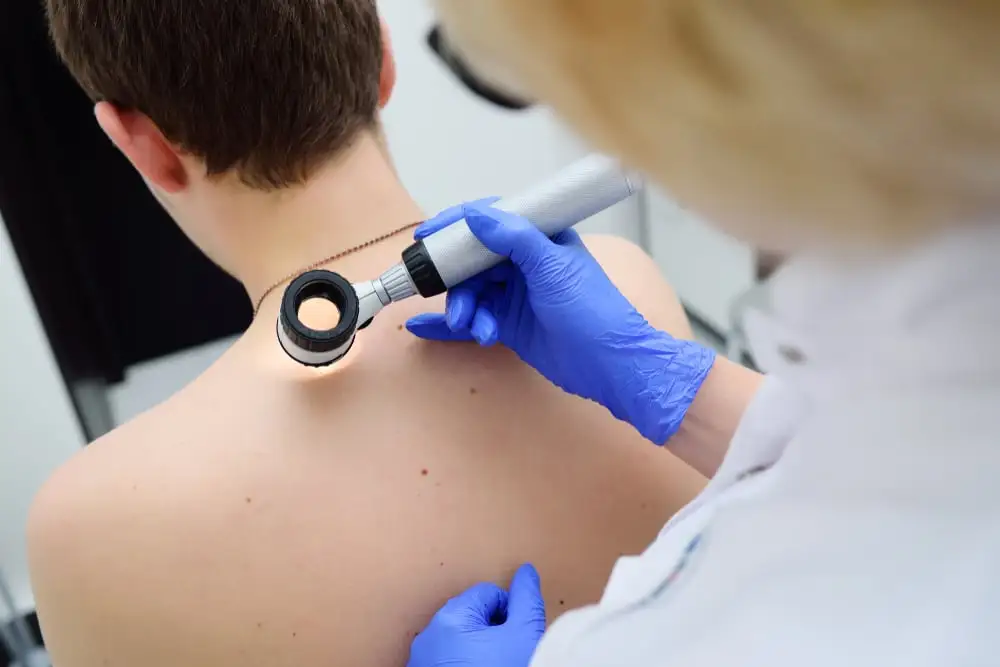
Skin cancer is the most common type of cancer in the United States, and it affects millions of people every year. Early detection and treatment are critical to the successful management of this condition. That’s why it’s essential to schedule regular skin cancer checks with a dermatologist.
A skin cancer check is a simple, painless examination of the skin that can identify the early signs of skin cancer. During the exam, your dermatologist will examine your entire body, including your scalp, nails, and the areas between your toes and fingers. They’ll look for any moles, freckles, or other spots on your skin that may be abnormal.
The dermatologist will evaluate the size, shape, color, and texture of each spot on your skin. They may use a dermatoscope, which is a special instrument that illuminates and magnifies the skin, to examine any suspicious areas in more detail. The doctor will also ask you about any symptoms you may be experiencing, such as itching, pain, or bleeding. They’ll also want to know about your medical history and any family history of skin cancer. This information can be important in determining your risk level for skin cancer and can help guide the doctor’s examination.
If the doctor finds a suspicious area, they may recommend a skin biopsy, which involves removing a small sample of skin tissue for further examination under a microscope. There are several types of skin biopsies, including shave biopsies, punch biopsies, and excisional biopsies, and the type recommended will depend on the location and size of the suspicious area. It’s important to remember that early detection is key when it comes to skin cancer, so don’t hesitate to schedule a skin cancer check with Dr. Raskin if you have any concerns or notice any changes in your skin.
Call us to schedule your appointment today.
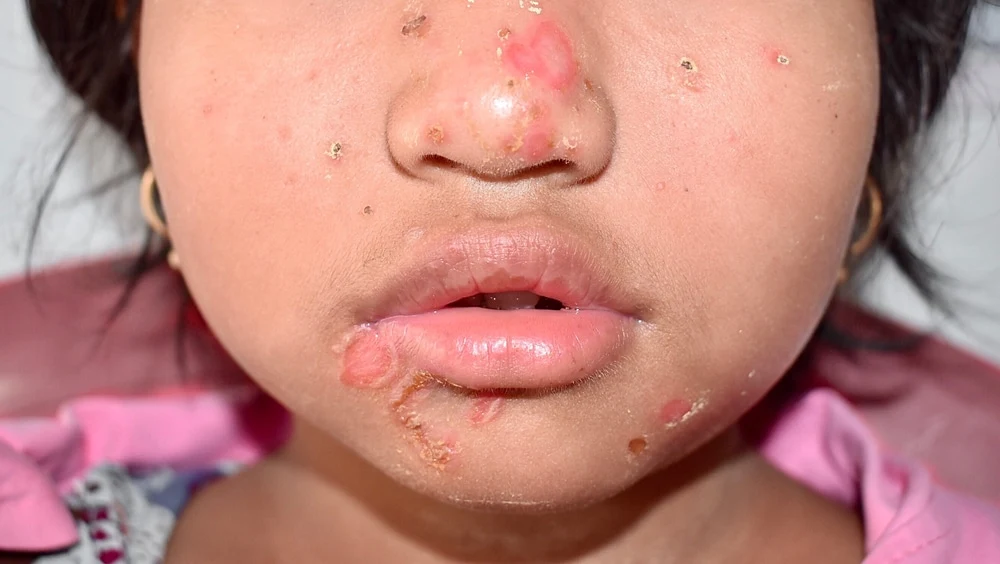
Impetigo is a contagious bacterial skin infection that commonly affects children but can occur at any age. The infection can spread easily, especially among children in close contact, such as in schools and daycare centers. If you suspect you or your child has impetigo, it is important to seek medical attention from a dermatologist, like Dr. Raskin in Bakersfield, who can diagnose and treat the condition.
Symptoms of Impetigo
Impetigo appears as red sores or blisters on the face, neck, hands, and other areas of the body. The sores may burst and develop honey-colored crusts, which can be itchy and uncomfortable. Impetigo can also cause swollen lymph nodes, especially in the affected area. In severe cases, impetigo can cause fever and chills.
Treatment of Impetigo
The most common treatment for impetigo is a course of antibiotics, either applied topically or taken orally. The type of antibiotic prescribed will depend on the severity of the infection and other factors. It is important to complete the full course of antibiotics, even if the symptoms improve or disappear, to prevent the infection from returning.
In addition to the treatments mentioned above, it is important to take measures to prevent the spread of impetigo. Here are some tips to keep in mind:
- Keep the affected areas clean: Clean the affected areas with soap and water regularly. This can help to remove the crusts and prevent the bacteria from spreading.
- Avoid touching the affected areas: Try to avoid touching the affected areas as much as possible. If you do touch them, make sure to wash your hands thoroughly with soap and water.
- Cover the affected areas: Cover the affected areas with a clean, dry bandage or gauze to prevent the spread of the bacteria to other parts of your body or to other people.
- Don’t share personal items: Avoid sharing personal items such as towels, clothing, or bedding with others, as this can spread the bacteria.
- Practice good hygiene: Good hygiene habits, such as washing your hands regularly, can help prevent the spread of impetigo and other infections.
If you suspect that you or someone in your family has impetigo, it is important to seek medical attention as soon as possible. Dr. Raskin and the medical staff at Advanced Dermatology & Cosmetic Care in Bakersfield can help diagnose and treat impetigo, as well as provide guidance on how to prevent its spread. With prompt and effective treatment, most cases of impetigo can be resolved within a few weeks. Call us for an appointment today!
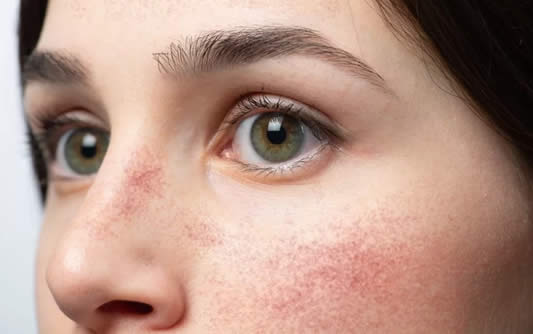
Rosacea is a chronic skin condition that affects millions of people worldwide. It’s characterized by redness, flushing, and visible blood vessels on the face, especially on the cheeks, nose, chin, and forehead. Rosacea can also cause papules, pustules, and thickened skin on the nose known as rhinophyma. It’s more common in fair-skinned individuals and women over 30, but it can affect anyone at any age.
Dr. Raskin in Bakersfield is a board-certified dermatologist who offers comprehensive care for rosacea. He and his team can help you identify the triggers that worsen your symptoms and customize a treatment plan to suit your needs. There is no cure for rosacea, but with the right approach, it’s possible to control the symptoms and prevent flare-ups.
The first step in treating rosacea is to avoid the triggers that exacerbate the condition. Some common triggers include sun exposure, heat, spicy foods, alcohol, and stress. It’s important to use gentle skincare products that don’t irritate the skin and avoid harsh exfoliants and abrasive scrubs. A good skincare routine for rosacea should include a mild cleanser, a fragrance-free moisturizer, and a broad-spectrum sunscreen.
If lifestyle changes and skincare alone are not enough, prescription medications may be necessary. The most common medications for rosacea include:
Topical antibiotics: These reduce inflammation and kill bacteria on the skin. Common examples include metronidazole, azelaic acid, and ivermectin.
Topical retinoids: These improve skin texture and reduce redness by regulating cell turnover. Tretinoin and adapalene are two retinoids commonly used to treat rosacea.
Oral antibiotics: These are prescribed in more severe cases of rosacea to reduce inflammation and kill bacteria from the inside out. Tetracycline, doxycycline, and minocycline are commonly prescribed antibiotics for rosacea.
Laser therapy: These treatments target visible blood vessels and redness, and can improve skin texture and tone. Dr. Raskin offers several types of laser treatments for rosacea, including pulsed dye laser and intense pulsed light therapy.
Living with rosacea can be frustrating, but with proper care and treatment, it’s possible to keep the symptoms under control. Don’t let rosacea rule your life – schedule an appointment with Dr. Raskin today to get the expert care you deserve.
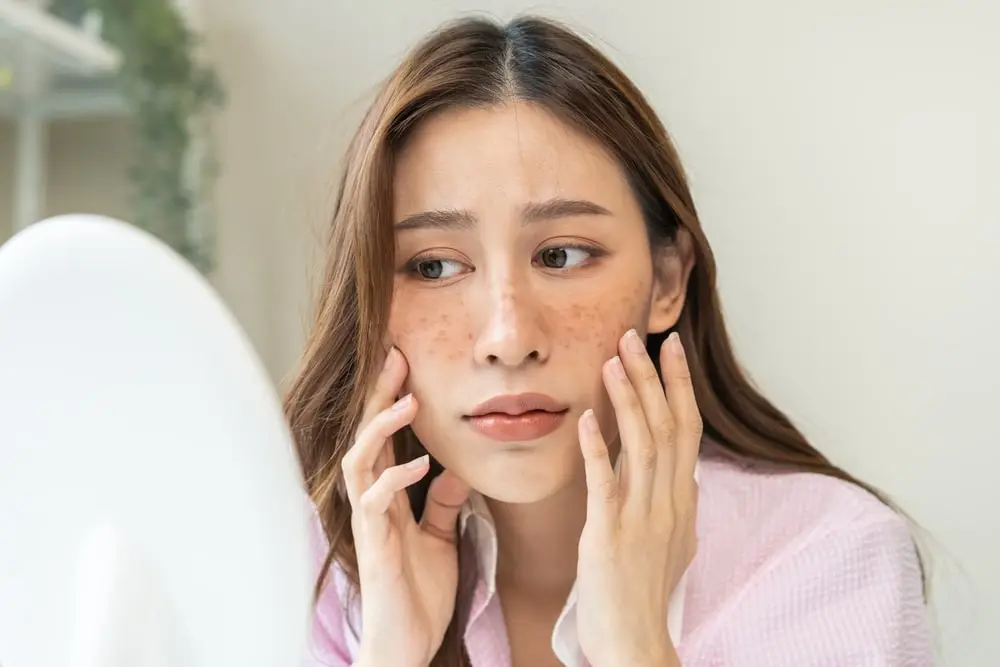
Melasma is a common skin condition that causes brown or grayish patches on the face, particularly on the cheeks, forehead, chin, and nose. It affects women more frequently than men, especially those with darker skin tones. Melasma is usually caused by hormonal changes, such as pregnancy, birth control pills, or hormone replacement therapy. However, sun exposure, genetics, and certain medications can also trigger melasma.
If you are experiencing melasma, don’t worry, you are not alone. Dr. Bernard Raskin at Advanced Dermatology can help you manage and treat this condition. With a combination of treatments, he can help to reduce the appearance of melasma and restore your skin’s natural beauty.
The first step in treating melasma is to protect your skin from the sun. Sunscreen with an SPF of at least 30 should be applied every day, and you should also wear a hat and sunglasses when outside. If you are taking hormone therapy, you may want to talk to your doctor about adjusting your medication to help prevent melasma.
Topical medications can also be used to treat melasma. Some of the most common topical medications include:
Hydroquinone – this bleaching agent helps to lighten the skin and reduce the appearance of melasma.
Retinoids – these vitamin A derivatives help to improve skin texture and reduce the appearance of melasma.
Corticosteroids – these anti-inflammatory agents help to reduce inflammation and redness associated with melasma.
In addition to these topical treatments, chemical peels and microdermabrasion can also be used to exfoliate the skin and reduce the appearance of melasma. Laser treatments may also be effective in treating melasma, although they are typically reserved for more severe cases.
If you are suffering from melasma, don’t hesitate to seek help from a Bakersfield dermatologist like Dr. Raskin. He can help to determine the underlying cause of your melasma and create a personalized treatment plan that works for you. With proper treatment and care, you can restore your skin’s natural beauty and feel confident in your appearance.
Schedule an appointment today.











